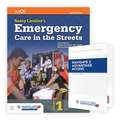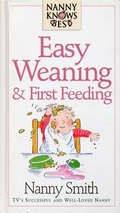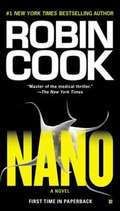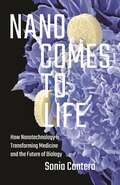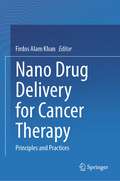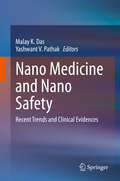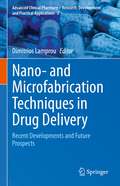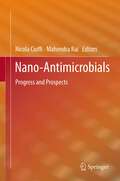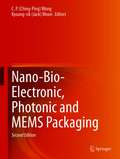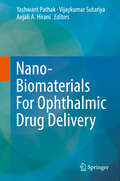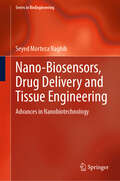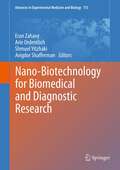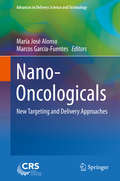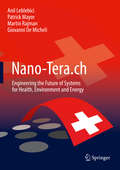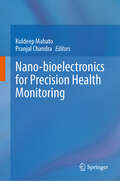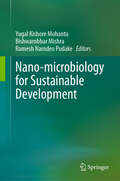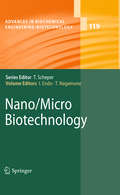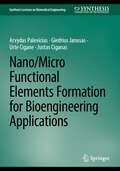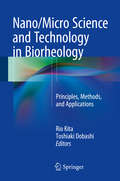- Table View
- List View
Nancy Caroline's Emergency Care in the Streets: Volume 2
by American Academy of Orthopaedic SurgeonsCareer Development. Recognizing that the U.S. health care system, and the role of the paramedic in it, are rapidly evolving, we've added a chapter on career development. In addition to discussing the changing and expanding career opportunities for paramedics, this chapter presents nontraditional specialties that paramedics may need in the future to fill evolving roles in the healthcare system.
Nanise', A Navajo Herbal: One Hundred Plants from the Navajo Reservation
by Vernon O. Mayes Barbara Bayless LacyNanise', A Navajo Herbal, co-authored by Vernon O. Mayes and Barbara Bayless Lacy, details 100 plants that are found on the Navajo Reservation, providing the reader with the Navajo name for each plant as well as ways the Navajos used them in everyday life, whether for ceremonial, medicinal or household purposes - complete with illustrations. The 100 plants are some of the most common Reservation flora of over 1,500 species of wild, vascular plants, including ferns, horsetails, conifers and flowering species and were selected by the Navajo Health Authority, Ethnobotany Project staff and approved by the Navajo Medicine Men's Association.
Nanny Knows Best - Easy Weaning And First Feeding
by Smith , Nanny With Nina GrunfeldFor many parents weaning can become full of trauma and anxiety. Is your baby eating enough? Is he getting the right nutrients? What happens if your baby refuses to eat or is constantly sick or crying? Nanny Smith has the answers to every parent's everyday questions and will help you and your baby through the transition from breast to bottle to solids - with confidence and calm.
Nano
by Robin CookA lavishly funded, security-conscious nanotechnology institute in the foothills of the Rockies, Nano is ahead of the curve in the competitive world of molecular manufacturing, including the construction of microbivores, tiny nanorobots with the ability to gobble up viruses and bacteria.<P> But when Pia Grazdani takes a job there, she's shocked by the secretive corporate culture. She's warned by her boss not to investigate the other work being done at the gigantic facility, nor to ask questions about the source of the seemingly endless capital that funds the institute's research. And when Pia encounters a fellow employee on a corporate jogging path suffering the effects of a seizure, she soon realizes she may have literally stumbled upon Nano's human guinea pigs. Is the tech giant on the cusp of one of the biggest medical discoveries of the twenty-first century--a treatment option for millions--or have they already sold out to the highest bidder?
Nano
by Robin CookA lavishly funded, security-conscious nanotechnology institute in the foothills of the Rockies, Nano is ahead of the curve in the competitive world of molecular manufacturing, including the construction of microbivores, tiny nanorobots with the ability to gobble up viruses and bacteria.But when Pia Grazdani takes a job there, she's shocked by the secretive corporate culture. She's warned by her boss not to investigate the other work being done at the gigantic facility, nor to ask questions about the source of the seemingly endless capital that funds the institute's research. And when Pia encounters a fellow employee on a corporate jogging path suffering the effects of a seizure, she soon realizes she may have literally stumbled upon Nano's human guinea pigs. Is the tech giant on the cusp of one of the biggest medical discoveries of the twenty-first century--a treatment option for millions--or have they already sold out to the highest bidder?
Nano Comes to Life: How Nanotechnology Is Transforming Medicine and the Future of Biology
by Sonia ConteraThe nanotechnology revolution that will transform human health and longevityNano Comes to Life opens a window onto the nanoscale—the infinitesimal realm of proteins and DNA where physics and cellular and molecular biology meet—and introduces readers to the rapidly evolving nanotechnologies that are allowing us to manipulate the very building blocks of life. Sonia Contera gives an insider's perspective on this new frontier, revealing how nanotechnology enables a new kind of multidisciplinary science that is poised to give us control over our own biology, our health, and our lives.Drawing on her perspective as one of today's leading researchers in the field, Contera describes the exciting ways in which nanotechnology makes it possible to understand, interact with, and manipulate biology—such as by designing and building artificial structures and even machines at the nanoscale using DNA, proteins, and other biological molecules as materials. In turn, nanotechnology is revolutionizing medicine in ways that will have profound effects on our health and longevity, from nanoscale machines that can target individual cancer cells and deliver drugs more effectively, to nanoantibiotics that can fight resistant bacteria, to the engineering of tissues and organs for research, drug discovery, and transplantation.The future will bring about the continued fusion of nanotechnology with biology, physics, medicine, and cutting-edge fields like robotics and artificial intelligence, ushering us into a new "transmaterial era." As we contemplate the power, advantages, and risks of accessing and manipulating our own biology, Contera offers insight and hope that we may all share in the benefits of this revolutionary research.
Nano Drug Delivery for Cancer Therapy: Principles and Practices
by Firdos Alam KhanThis book discusses the various modes and methods of nano-based drug delivery in different types of cancers such as colon, breast, cervical, ovarian, and lung cancer. It reviews the significance of nano drug delivery in cancer therapy, the application of nanoparticles in overcoming drug resistance, targeted therapy, and immunotherapy. The book also covers topics related to the synthesis of different types, shapes, and sizes of nanocarriers using synthetic and biological approaches. Further, a chapter explores the synthesis of nanocarriers loaded with anti-cancer drugs by using functionalization or conjugations and encapsulation methods. The book also examines the nanocarriers as delivery vehicles for chemotherapeutic agents against cancers using in vitro and animal models of cancers, preclinical trials for efficacy, and safety profiling of nanocarriers. Finally, future trends and innovation in nano drug delivery for cancer therapy, application of siRNA (nanoparticle-based RNA) therapy, ultrasound-linked nano-cancer therapeutics, and application of exosome-based cancer therapy topics are discussed. Towards the end, the book examines the limitations of nanocarriers, including the cell and tissue toxicity, genotoxicity, and scale-up of nanomaterials, health and environmental hazards associated with nanoformulation synthesis, respiratory diseases, government regulations, and ethical issues.
Nano Medicine and Nano Safety: Recent Trends and Clinical Evidences
by Malay K. Das Yashwant V. PathakThis book reviews the application of Nanobiotechnology in the development of Nanomedicine, while also discussing the latest trends and challenges in the clinical translation of Nanomedicine. Nanomedicine refers to the application of Nanotechnology to medicine and holds tremendous potential for achieving improved efficiency, bioavailability, dose response, personalized medicine and enhanced safety as compared to conventional medicines.The book first introduces readers to the basic concepts of Nanomedicine, and to technological advances in and applications of Nanotechnology in treatment, diagnosis, monitoring, and drug delivery. In turn, it reviews the current status of multi-functionalization strategies for using Nanoparticles in the targeted delivery of therapeutic agents. The book’s third and final section focuses on the regulatory and safety challenges posed by Nanomedicine, including industry and regulatory agencies’ efforts to address them.
Nano Metal Oxides: Engineering and Biomedical Applications
by B. Karthikeyan G. Gnanakumar A. Therasa AlphonsaThis book highlights theoretical and experimental facts about selective nano-metal oxides. TiO2 ,ZnO and transition metal oxides which are known to be semiconductors and find applications in various fields. This book presents about recent findings like photo catalysis, sensing ,coating and biomedical applications. Therapeutic and future applications that are recently been reported of various metal oxides are presented in this book.
Nano- and Microfabrication Techniques in Drug Delivery: Recent Developments and Future Prospects (Advanced Clinical Pharmacy - Research, Development and Practical Applications #2)
by Dimitrios LamprouNew materials and manufacturing techniques are evolving with the potential to address the challenges associated with the manufacture of medicinal products that will teach new tricks to old drugs. Nano- and microfabrication techniques include manufacturing methods such as additive manufacturing, lithography, micro-moulding, spray drying, and supercritical fluids among many others. The increasing resolution of new techniques allow researchers to produce objects with micrometric resolutions. This book follows a consecutive order, beginning with a background in the current field and limitations in the manufacturing of different pharmaceutical products, moving on the classification of each method by providing recent examples, and future prospective on a variety of traditional and new Nano and microfabrication techniques. A focus on the materials used to prepare these systems and their biocompatibility, including applied topics such as clinical applications and regulatory aspects also covered, offering the reader a holistic view of this rapidly growing field.
Nano-Antimicrobials
by Mahendra Rai Nicola CioffiThere is a high demand for antimicrobials for the treatment of new and emerging microbial diseases. In particular, microbes developing multidrug resistance have created a pressing need to search for a new generation of antimicrobial agents, which are effective, safe and can be used for the cure of multidrug-resistant microbial infections. Nano-antimicrobials offer effective solutions for these challenges; the details of these new technologies are presented here. The book includes chapters by an international team of experts. Chemical, physical, electrochemical, photochemical and mechanical methods of synthesis are covered. Moreover, biological synthesis using microbes, an option that is both eco-friendly and economically viable, is presented. The antimicrobial potential of different nanoparticles is also covered, bioactivity mechanisms are elaborated on, and several applications are reviewed in separate sections. Lastly, the toxicology of nano-antimicrobials is briefly assessed.
Nano-Bio- Electronic, Photonic and MEMS Packaging
by Yi Li Kyoung-Sik Jack Moon C. P. Ching-Ping WongThis book shows how nanofabrication techniques and nanomaterials can be used to customize packaging for nano devices with applications to electronics, photonics, biological and biomedical research and products. It covers topics such as bio sensing electronics, bio device packaging, MEMS for bio devices and much more, including:Offers a comprehensive overview of nano and bio packaging and their materials based on their chemical and physical sciences and mechanical, electrical and material engineering perspectives;Discusses nano materials as power energy sources, computational analyses of nano materials including molecular dynamic (MD) simulations and DFT calculations;Analyzes nanotubes, superhydrophobic self-clean Lotus surfaces;Covers nano chemistry for bio sensor/bio material device packaging.This second edition includes new chapters on soft materials-enabled packaging for stretchable and wearable electronics, state of the art miniaturization for active implantable medical devices, recent LED packaging and progress, nanomaterials for recent energy storage devices such as lithium ion batteries and supercapacitors and their packaging. Nano- Bio- Electronic, Photonic and MEMS Packaging is the ideal book for all biomedical engineers, industrial electronics packaging engineers, and those engaged in bio nanotechnology applications research.
Nano-Biomaterials For Ophthalmic Drug Delivery
by Yashwant Pathak Vijaykumar Sutariya Anjali A. HiraniThis consolidated reference book addresses the various aspects of nano biomaterials used in ophthalmic drug delivery, including their characterization, interactions with ophthalmic system and applications in treatments of the ophthalmic diseases and disorders. In the last decade, a significant growth in polymer sciences, nanotechnology and biotechnology has resulted in the development of new nano- and bioengineered nano-bio-materials. These are extensively explored as drug delivery carriers as well as for implantable devices and scaffolds. At the interface between nanomaterials and biological systems, the organic and synthetic worlds merge into a new science concerned with the safe use of nanotechnology and nano#65533; material design for biological applications. For this field to evolve, there is a need to understand the dynamic forces and molecular components that shape these interactions. While it is impossible to describe with certainty all the bio#65533; physicochemical interactions at play at the interface, we are at a point where the pockets of assembled knowledge are providing a conceptual framework to guide this exploration, and review the impact on future product development. The book is intended as a valuable resource for academics and pharmaceutical scientists working in the field of polymers, polymers materials for drug delivery, drug delivery systems and ophthalmic drug delivery systems, in addition to medical and health care professionals in these areas.
Nano-Biosensors, Drug Delivery and Tissue Engineering: Advances in Nanobiotechnology (Series in BioEngineering)
by Seyed Morteza NaghibThis book highlights a novel combination of nanotechnology and biotechnology enabling the practical use of conventional microtechnology in conjunction with a molecular approaches in cancer detection and treatment. As nanotechnology and biotechnology have advanced, the methods such as nanoimaging, nanobiosensing, nanolabeling, nanodiagnostics, and nanotherapeutics have developed. The pricey old manufacturing process will be replaced by the new expanding field of nanobiotechnology, which will produce durable, flexible, and accurate devices at a lower cost and with less environmental impact. Drug distribution, sensor systems, small robots, and surgical instruments might all benefit from the development of stronger materials made possible by this technique. Nanobiotechnology may be used to create atomic grade machines by merging or simulating biological processes or creating tiny tools to alter many aspects of the living system at the molecular level. This book presents a state-of-the art technology that enhances our existing knowledge and ideas integrating chemistry, physics, and biology. The book discusses a number of cutting edge medical technologies that use nanoparticles as delivery or sensing systems are examples of nanobiotechnology as they employ nanotechnology to further biological objectives.
Nano-Biotechnology for Biomedical and Diagnostic Research
by Arie Ordentlich Avigdor Shafferman Eran Zahavy Shmuel YitzhakiThe title "Nano Biotechnology for Biomedical and Diagnostics Research" will address research aspects related to nanomaterial in imaging and biological research, nanomaterials as a biosensing tool, DNA nanotechnology, nanomaterials for drug delivery, medicinal and therapeutic application and cytotoxicity of nanomaterials. These topics will be covered by 16 different manuscripts. Amongst the authors that will contribute to the book are major scientific leaders such as S. Weiss - UCLA, I. Willner, and G. Golomb - HUJI, S. Esener - UCSD, E.C. Simmel - Tech. Univ. Munchen, I. Medintz - NRL, N. Hildebrandt - Université Paris and more. The manuscripts in the book intend to present specifically biological, diagnostics and medical problems with their potential solution by nano technology or materials. In this respect this book is unique, since it would arise from the biological problems to the nano technology possible solution and not vice versa.
Nano-Oncologicals
by Maria José Alonso Marcos Garcia-FuentesThis authoritative volume focuses on emerging technologies in cancer nano medicine, characterized by their multi-functionality and potential to address simultaneously diverse issues of clinical relevance in the treatment of cancer. The book consists of sixteen chapters divided into six sections: 1) Biological Barriers in Cancer; 2) Tumor Targeting; 3) Targeting the Immune System; 4) Gene Therapy; 5) Nano theranostics and 6) Translational Aspects of Nano-Oncologicals. The volume starts with an introduction describing the biological barriers associated with cancer therapy and highlighting ways to overcome such barriers through the use of nanotechnology. This is followed by an analysis of the two major targeting strategies currently under investigation in cancer therapy: namely, the targeting of cancer cells and the targeting of the immune system. In the first case, the book presents liposomal and polymer-based therapies, including photodynamic approaches. In the second case, it analyzes in detail the possibility of either improving the efficiency of the immune system toward preventing cancer progression (cancer immunomodulation) or generating responses against specific cancer antigens (cancer vaccines). Beyond these targeting options, Nano-Oncologicals: New Targeting and Delivery Approaches presents the most recent technological advances in the area of nucleic acid-based therapies, along with those in the area of theranostics, where the design of multifunctional nano carriers becomes vital. Following the study of the most promising nanotechnologies around the development of nano-oncologicals, the book ends with an overview of regulatory and toxicological issues, which are critical in their translational pathway, and the presentation of a nucleic acid-based therapy case-study. This book is an important resource for scientists interested in the design and development of anticancer nanotechnologies and also to those aiming to push their technology through clinical development.
Nano-Strategies for Addressing Antimicrobial Resistance: Nano-Diagnostics, Nano-Carriers, and Nano-Antimicrobials (Nanotechnology in the Life Sciences)
by Vinay Kumar Varsha Shriram Ravi Shukla Suresh GosaviAntibiotics, the backbone of modern clinical-medicine, are facing serious challenges from emerging antimicrobial-resistance (AMR), a complicated phenomenon expanding in bacterial species, from nosocomial to community origins, where microbes are no longer sensitive to a range of commonly used antibiotics. AMR has exploded in recent years and is posing a serious threat to human health and survival. This necessitates novel and effective ways of diagnosis, drug-delivery, and treatment; nanotechnology and advanced nanomaterials are hailed as a potent solution in containing AMR.The main thrust of this volume is to explain the most current research on the central theme of potential use of nano-approaches for diagnosis, detection, drug-delivery and as antimicrobial agents against drug-resistant pathogenic microbes. This book provides an integrated blend of basic and advanced information for students, scholars, scientists and practitioners, interested or already engaged in research in these areas. We have brought together leading international authors to present and highlight various aspects of nanotechnology in combating AMR in WHO-prioritized microbes. Topics range from advances in nanomaterial synthesis, characterization, functionalization and improvisation, as well as applications in sensing, diagnosis of AMR, and their therapeutic and drug-delivery potential against MDR and XDR microbial phenotypes.
Nano-Tera.ch: Engineering the Future of Systems for Health, Environment and Energy
by Anil Leblebici Patrick Mayor Martin Rajman Giovanni De MicheliThis book presents the overall vision and research outcomes of Nano-Tera.ch, which is a landmark Swiss federal program to advance engineering system and device technologies with applications to Health and the Environment, including smart Energy generation and consumption. The authors discuss this unprecedented nation-wide program, with a lifetime of almost 10 years and a public funding of more than 120 MCHF, which helped to position Switzerland at the forefront of the research on multi-scale engineering of complex systems and networks, and strongly impacted the Swiss landscape in Engineering Sciences.
Nano-bioelectronics for Precision Health Monitoring
by Pranjal Chandra Kuldeep MahatoThis Book offers a scholarly and in-depth exploration of the emerging field that brings together nanotechnology, biosensing, and electronic systems to support the growing vision of personalized and precision healthcare. As modern medicine moves away from generalized treatment approaches toward individualized, data-driven care, this book highlights the critical role of nano-bioelectronics in enabling real-time monitoring, early disease detection, and tailored clinician interventions for managing chronic diseases.In this book, readers will find detailed discussions on the design and application of wearable, implantable, and ingestible biosensors capable of continuously tracking a wide range of physiological and biochemical signals. Covering both theoretical foundations and applied innovations, the book addresses key areas such as cardiovascular health, diabetes management, neurodegenerative disease monitoring, and therapeutic drug tracking. Core topics include the science of biomarkers, sensor miniaturization, materials for bio-interfaces, and strategies for enhancing sensitivity, selectivity, and long-term stability of biosensors. This volume also presents advanced developments in multimodal sensing platforms, flexible and skin-conformable electronics, and the integration of biosensing systems with wireless communication, cloud infrastructure, and machine learning for automated health analytics. These technologies offer the potential to redefine health monitoring from hospital-centric models to continuous, patient-centric solutions. Written for researchers, biomedical engineers, clinicians, and health technology developers, this book serves as both a foundational reference and a forward-looking guide. Readers will find not only comprehensive insights into current technologies but also a vision for future innovations that aim to make precision health a practical and impactful reality.
Nano-formulation of Dietary Phytochemicals for Cancer Management
by Nidhi PuranikThis book covers various cancer chemotherapeutics, offering research-oriented overviews of phytochemical-based cancer treatments. It contrasts nano-formulated phytochemical delivery with conventional chemotherapy, introducing nanocarriers or bioengineering for poly-chemotherapy and phytochemicals as alternative treatments to reduce resistance. The text elaborates on the nano-formulation techniques and synthesis approaches of phytochemicals as drugs, the targeted drug delivery facilitated by nanocarriers, and subsequent mechanisms of drug release. Additionally, it examines the implications of nano-formulated phytochemicals in cancer therapeutics and their impact on cancer treatment and prevention. By enhancing bioavailability and improving functional qualities through nanoencapsulation, this innovative approach promises significant advancements in cancer therapy. Key concepts include dietary phytochemicals' role in various types of cancer chemotherapeutics, the pharmacological mechanisms of action in prevention and treatment, and strategies to enhance chemotherapy and radiotherapy efficacy. The book also presents preclinical and clinical studies on the efficacy of phytochemicals in cancer treatment. Additionally, it highlights improvements in drug delivery systems using nanotechnology-based dosage forms for herbal drugs. The content is designed for professionals involved in drug development, including chemists, pharmacists, biologists, biotechnologists, industrialists, nanotechnologists, microbiologists, economists, and all disciplines related to cancer treatment and phytochemical-based drug development. Academic students, scientists, and researchers at universities, institutes, hospitals, botanical institutes, pharmaceutical industries, government organizations, and NGOs will find invaluable insights into the application of phytochemical drugs in cancer treatment. By providing a detailed examination of cutting-edge research on nano-formulated phytochemicals for cancer therapy, this book invites readers to rethink traditional approaches to chemotherapy and explore innovative solutions that promise better outcomes for patients worldwide.
Nano-microbiology for Sustainable Development
by Ramesh Namdeo Pudake Yugal Kishore Mohanta Bishwambhar MishraMicrobial diversity and microbial technology are critical to achieving most of the UN Sustainable Development Goals (SDGs), mainly due to their central role in the provision and regulation of ecosystem services. Despite this intensification of effort, more than 90% of microbial diversity remains to be discovered. Thus, the most unique characteristic of microbial technology is the exceptional diversity of applications it can address and the range of human activities and needs to which it is and can be applied. Separately, nanotechnology and microbiology have produced innovative solutions for human well-being and ecological and environmental equilibrium. The development of interdisciplinary research practices combining nanotechnology and microbiology to deliver creative solutions for human health and environmental and ecological damage is urgently required. The nanotechnology of microorganisms is contributing to the development and innovation of numerous industries. This book will explain the fundamentals and methods of the biological production of nanoparticles from microorganisms, such as bacteria, fungi, and algae. It will describe optimization strategies for microbe-mediated nanoparticle production. The book will also discuss the industrial and agricultural applications of nanoparticles produced by microbes. It also describes the applications of green nanoparticles in the health and pharmaceutical sectors, such as the treatment of multidrug-resistant infections and cancer. Overall, the book focuses on the broad subject areas of microbial nanotechnology and its possible applications in food, pharmaceuticals, water, environmental remediation, etc. However, the lack of information and the potential for negative effects on the environment, human health, safety, and sustainability remain obstacles. This book addresses these issues. Researchers and students in the agricultural sciences, materials sciences, biotechnology, microbiology, and pharmaceutical sectors will find this an invaluable resource.
Nano-phytoremediation and Environmental Pollution: Strategies and Mechanisms
by Khalid Rehman Hakeem Rouf Ahmad Bhat Gowhar Hamid Dar Fernanda Maria Policarpo TonelliThe book discusses nano-phytoremediation: the use of nanotechnology in combination with phytoremediation to restore polluted environs. The potentiality of plants in association with nanomaterials to effectively remediate polluted areas is elaborated meritoriously in this book. New strategies are necessary because anthropogenic actions represent a serious threat to life on Earth. This book has given enough space for a discussion of innovative and efficient technologies to restore damaged environs primarily focused on nano-phytoremediation. The first part of the book is dedicated to exploring organic and inorganic pollution and the threats they pose to living forms. The second part explores the joint use of plants and nanomaterials and the nano-phytoremediation of water and soil ecosystems. The book offers readers extensive knowledge on nano-phytoremediation as a feasible strategy to clean environmental pollution. The key features of the book are as follows: Nano-phytoremediation strategies to remediate soil and water ecosystems. Special chapters dedicated to different kinds of pollutants and methods of phytoremediation. Strategies to evaluate the success of nano-phytoremediation strategies, cost-effectiveness, and nano informatics to safe nanotechnology. The book can be used as a primary or supplementary text in undergraduate, graduate, and post-graduate courses such as biotechnology, biochemistry, and environmental engineering. It is an interesting edition for instructors, researchers, and scientists working on environmental management and pollution control.
Nano/Micro Biotechnology
by Isao Endo Teruyuki NagamunePart I The Nano-Scale Biological Systems in Nature; Molecular bio-motors in living cells - by T. Nishizaka; The form designed by viral genome - by K. Onodera; Part II Detection and Characterization Technology; Atomic force microscopy applied to nano-mechanics of the cell - by A. Ikai; Design, synthesis and biological application of fluorescent sensor molecules for cellular imaging - by K. Kikuchi; Dynamic visualization of cellular signaling - by Q. Ni and J. Zhang; Part III Fabrication Technology; Surface acoustic wave atomizer and electrostatic deposition - by Y. Yamagata; Electrospray deposition of biomolecules by V.N. Morozov; Part IV Processing Technology; Droplet handling - by T.Torii; Integrated microfluidic systems - by S. Kaneda and T. Fujii; Part V Applications; A novel non-viral gene delivery system: Multifunctional envelope-type nano device - by H. Hatakeyama, H. Akita, K. Kogure, and H. Harashima; Biosensors - by M. Saito, H.M. Hiep, N. Nagatani, and E.Tamiya; Micro bioreactors - by Sato and T. Kitamori
Nano/Micro Functional Elements Formation for Bioengineering Applications (Synthesis Lectures on Biomedical Engineering)
by Giedrius Janusas Arvydas Palevicius Urte Cigane Justas CiganasIn recent years, various technologies dedicated to the formation of micro- and nanostructures have been intensively developed. Microstructures and nanostructures are manufactured from various materials with different parameters in a wide range of industrial sectors. These structures are used in devices such as biosensors, optical devices, microfluidic devices, electronic components, fluid mixing devices, particle separation or mixing devices, and single-molecule analysis devices. In this book technologies are being developed for the formation of nano/micro structures that allow the creation of new types of functional elements used in bioengineering. A magnetostrictive converter was developed and studied for the formation of microstructures in polymers, and a newly developed technology using mechanical vibrations during the chemical process was used to form aluminum nanopores. The synergy of these two technologies ensures the creation of a new type of functional elements used in bioengineering. It is presented how to replace the piezoelectric transducer with a magnetostrictive transducer in order to improve hot embossing technology for formation microstructures in polymers. The improved transducer would not only allow for the formation of structures at higher temperatures but would also eliminate the need for an additional heating element which generates a significant amount of heat during the process, thus optimising the device. The important aspects of this system include determining the working parameters of the structure formation which affect the quality and reproducibility of the structures. Research related to nanostructured nanoporous membranes has been receiving a lot of attention from scientists and businesspeople, which is why it is important to develop technologies and deepen knowledge about the chemical and physical processes that take place during fabrication to solve the challenges related to nanostructured membranes. Having it in mind this book presents a novel fabrication technology of nanoporous AAO membranes using vibrations, including production processes, their parameters, and a description of the properties of the fabricated membranes. Moreover, the book presents a technology for replicating the geometry of the AAO membrane in a biocompatible chitosan membrane, when nanopillars are formed on the surface of the chitosan membrane. It also presents the relationships and interactions studied between various parameters, which is achieved by presenting sets of experimental results. Combining these technologies the manufacturing of functional elements and their application to bioengineering. The book will be useful for researchers not only in Mechanical Engineering but also for Material Science and Chemical Engineering. It could be used for master and Ph.D. students too.
Nano/Micro Science and Technology in Biorheology
by Rio Kita Toshiaki DobashiIntegrating basic to applied science and technology in medicine, pharmaceutics, molecular biology, biomedical engineering, biophysics and irreversible thermodynamics, this book covers cutting-edge research of the structure and function of biomaterials at a molecular level. In addition, it examines for the first time studies performed at the nano- and micro scale. With innovative technologies and methodologies aiming to clarify the molecular mechanism and macroscopic relationship, Nano/Micro Science and Technology in Biorheology thoroughly covers the basic principles of these studies, with helpful step-by-step explanations of methodologies and insight into medical applications. Written by pioneering researchers, the book is a valuable resource for academics and industry scientists, as well as graduate students, working or studying in bio-related fields.
